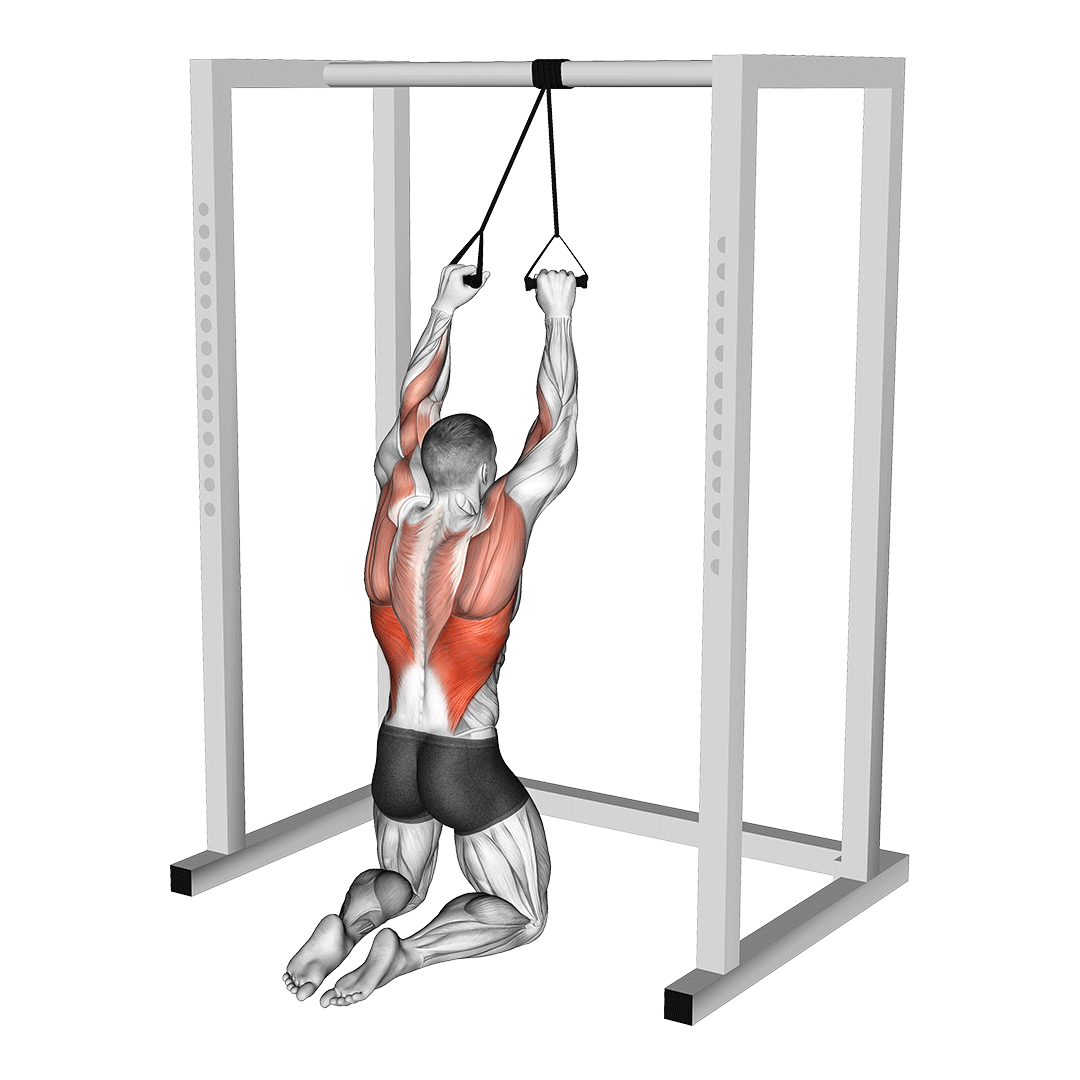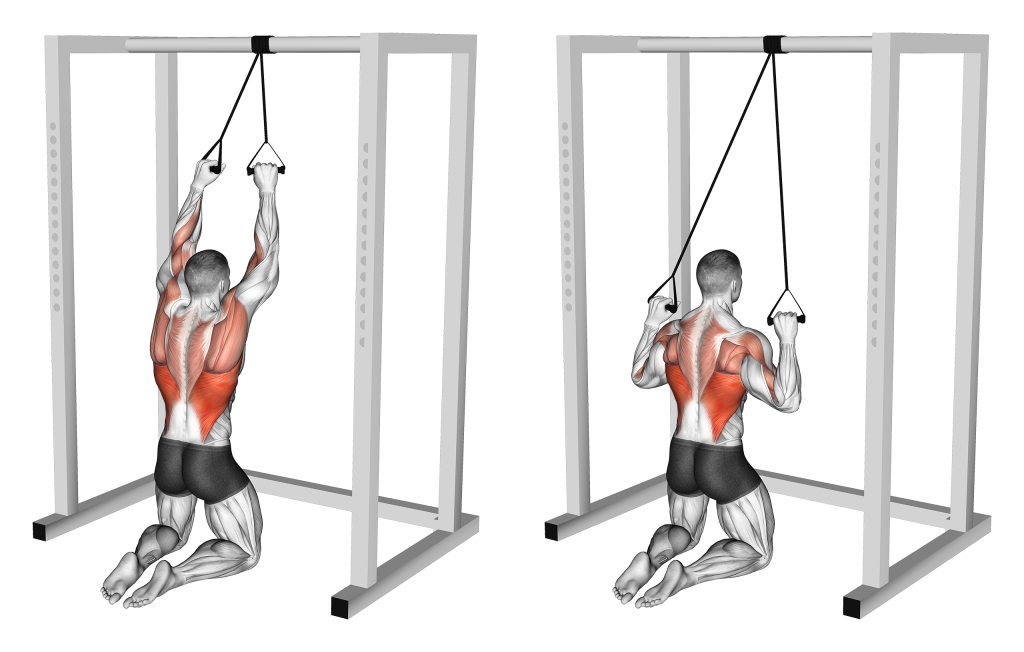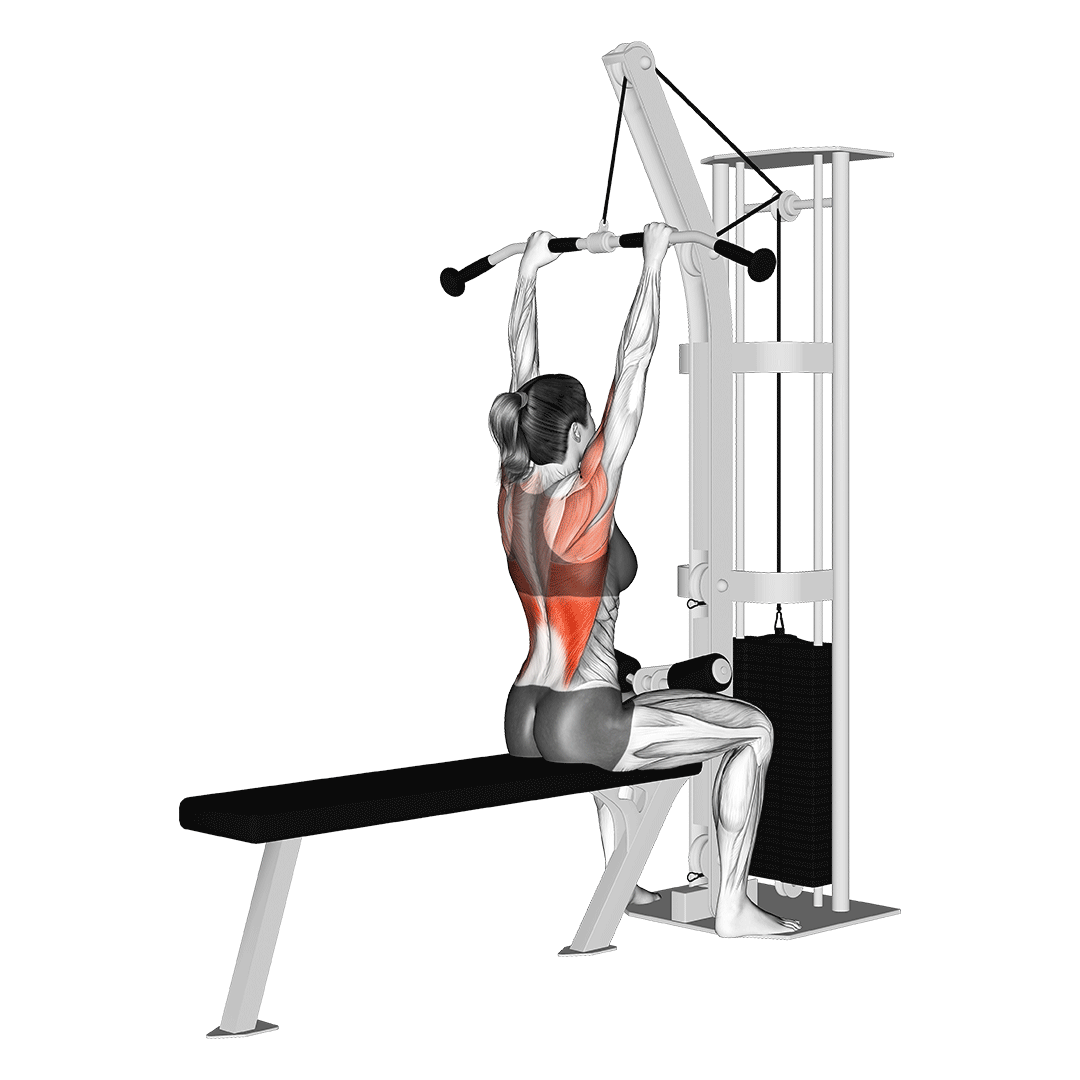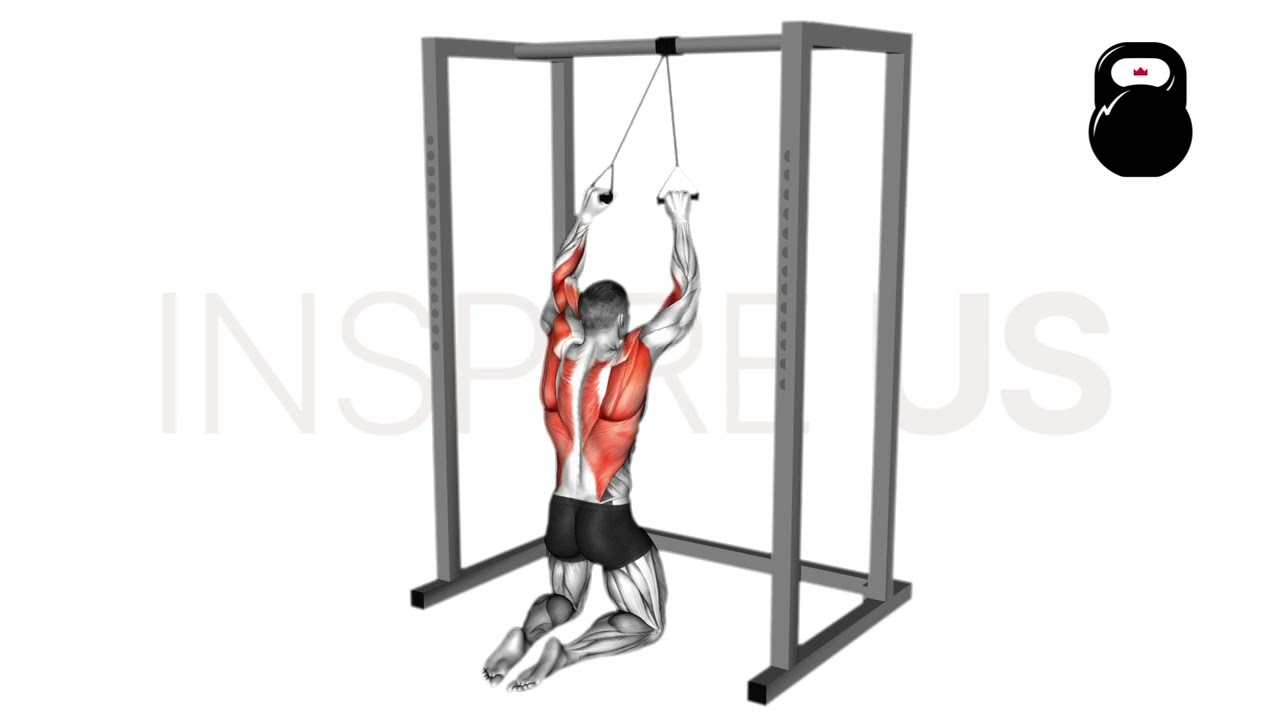Resistance Band Lat Pulldown: Benefits, Muscles Worked, and More
The resistance band lat pulldown is a compound vertical pulling exercise involving use of scapular retraction, scapular depression and elbow flexion as its main mechanical actions.

Most frequently, the resistance band variation of lat pulldown is used as an at-home or in-clinic alternative to the far more demanding and inconvenient machine lat pulldown. Those who do not have access to a gym or wish to avoid resistance training machines can make use of the banded variation instead.
Apart from being used as an equipment substitute, the resistance band also allows for a variable level of tension throughout the exercise’s range of motion.
If positioned just right, the band can feature far less tension near the start and end of the repetition, aiding with mobility or better targeting certain back muscles for strength development.
In actual strength, conditioning or bodybuilding programs, the banded lat pulldown is used as a secondary compound movement after heavier and more complex exercises like the barbell row or pull-up have already been completed.
How to Do Banded Lat Pulldowns
To perform a repetition of the resistance band lat pulldown, the lifter will first affix the center of the band to an anchor point over their head, holding both ends of the band in their hands with a neutral grip.
Standing or kneeling a sufficient distance from the anchor point so that the band exerts resistance, the lifter then leans their torso slightly back, pushes their chest out and rolls their shoulders into a neutral position as they squeeze their lats.
This should draw the band downwards as the elbows bend towards the sides of the torso, the scapula retracting as they do so.
Once the elbows are bent parallel to the sides of the body and the scapula is fully retracted, the lifter then allows the resistance of the band to slowly pulley their arms straight - returning to the original beginning position. At this point, the repetition is considered to be complete.
The exercise may also be performed with the use of a pronated or underhand grip, but doing so may be difficult with traditional resistance bands. For a nearly identical exercise that allows for different grip orientations to be used, try the TRX lat pulldown.
Sets and Reps Recommendation:
The banded lat pulldown may be difficult to adjust as far as actual resistance is concerned.
As such, aim for 2-3 sets of 10-20 repetitions, increasing set volume or the length of each repetition as you progress.
What Muscles are Worked by Resistance Band Lat Pulldowns?
Like traditional lat pulldowns, the resistance band variation is classified as a compound movement due to its involvement of multiple muscle groups.

These muscles are further divided according to the role they play, with primary and secondary mover muscles exhibiting dynamic contraction and stabilizer muscles solely exhibiting isometric contraction.
Because dynamic contraction under load is significantly more taxing, it is also these same muscles that will receive the most benefit from the exercise.
In comparison, stabilizer muscles are fatigued to a far lesser degree, but are unlikely to respond in the form of hypertrophy or any significant neurological strength development.
Mover Muscles
In terms of primary mover muscles, the latissimus dorsi and teres major muscles play the most significant role during resistance band lat pulldowns.
The exact extent of their involvement will depend on grip and hand positioning, with a wider and more pronated grip equating to greater emphasis on the lats and teres major.
In addition to the primary movers, the teres minor, trapezius, rhomboids and biceps brachii will play a secondary mover role as well.
Stabilizer Muscles
Mover muscles notwithstanding, banded lat pulldowns will also recruit the posterior deltoid head, brachialis and brachioradialis to help stabilize the arm and shoulder joints.
What are the Benefits of Doing Band Lat Pulldowns?
Resistance band lat pulldowns are most often performed over other pulldown variations for their convenience and capacity to act as a substitute exercise, rather than because they are an inherently superior movement.
Nevertheless, the exercise is still an all-around solid choice for developing greater mobility, strength and muscle mass in the back - alongside a whole host of further benefits.
Builds Strength, Stability and Mass in the Back
The main advantage to banded lat pulldowns (and other variants) is their capacity to develop overall strength and mass in the muscles of the back.
As the principle mover of the exercise, the lats benefit the most from this advantage - but so too do the smaller muscles of the mid-back, such as the rhomboids or teres major.
The banded lat pulldown is particularly effective for improving muscular stability and general pulling strength, as the consistent level of tension and adjustability of the band provide a constant challenge to these muscle groups.
Reinforces Elbow Flexion, External Shoulder Rotation and Scapular Retraction
As a combination of both its muscular strengthening benefits and gentle dynamic tension of the joints, resistance band exercises are among the best for reinforcing and rehabilitating biomechanical actions.
For the resistance band lat pulldown in particular, these mechanics are largely elbow flexion, external shoulder rotation as well as both retraction and depression of the scapula.
Not only does regularly performing the exercise improve the stability and strength with which these biomechanics are executed, but they will also be improved in terms of range of action as well.
Of course, remember to first speak to your physical therapist prior to self-rehabilitating any injuries with the banded lat pulldown.
Can be Adjusted for Variable Resistance
Resistance bands are largely unique in that they exert a variable level of resistance depending on how far the band is stretched from its anchor point.
Lifters that wish to reduce the involvement of their elbow flexor muscles while still targeting their back muscles can simply stand closer to the anchor point, creating slack in the band until the initial half of the range of motion has already been completed.
More advanced athletes can take advantage of this to improve the specificity of their training - or to otherwise develop power and explosiveness in their horizontal pulling muscles.
Low Injury Risk, Highly Convenient and Low Budget
As mentioned previously, the main benefit to resistance band exercises lies in their convenience, relatively low cost and comparative safety.
Resistance bands are among the lightest forms of resistance equipment available, being small enough to fit in a luggage bag or to tuck away in a drawer. For lifters on vacation or those who prefer to train at home, such convenience can be a boon.
This advantage further ties into the relatively low price of bands in comparison to equipment like resistance machines or free weights.
If building a home workout system on a budget, bands are the best way to maximize resistance for as few dollars as possible.
Finally, resistance bands also offer the benefit of being comparatively safer than most other forms of resistance equipment. As a more convenient and accessible type of training tool, this low risk of injury makes them ideal for novices or rehabilitation patients just getting back into the swing of training.
Used for Physical Rehabilitation of Postural Issues, Instability and Poor Mobility
Outside of a training setting, banded and machine lat pulldowns are also used to help correct certain issues related to the muscles of the lower back.
Among the more common of these are postural issues caused by muscular weakness, a lack of stability in regards to the scapula and shoulder joints - or overall poor mobility in all dynamically involved structures.
Common Resistance Band Lat Pulldown Mistakes to Avoid
Despite their safety and overall accessibility, resistance band lat pulldowns are not foolproof. Ensure that the following common mistakes are corrected so as to avoid injury or poor training response.
Poor Range of Motion
A mistake seen in nearly all high-tension exercises - a poor or incomplete range of motion can lead to the development of sticking points, instability and generally poor development in certain muscle groups.
Completing a full range of motion is especially important with banded lat pulldowns, as the band tends to increase in tension the further it is stretched.
Failing to fully bend the elbows or retract the scapula can cause the muscles of the back to become undertrained or entirely eliminated from the movement.
For the best possible results, ensure each repetition begins and ends with the arms extended towards the anchor point. Furthermore, the apex of the movement must also involve the elbows bent parallel to the sides of the torso, if not behind it.
Flaring the Elbows
A common mistake seen with most pulldown variations is an excessively high elbow pulling angle, often to the point of flaring them out to the sides.
Within the shoulder joint, the bone of the upper arm (humerus) can rotate at a disadvantageous angle, causing the tendons to become irritated and eventually developing issues like bursitis or tendinopathy.
Apart from non-training related causes, this sort of issue is most often caused by flaring the elbows during heavy pushing or pulling movements.
During the banded lat pulldown, aim to keep the elbows in a path close to the torso, preventing them from pointing out to the sides as much as possible. If the upper arms are parallel to the shoulder, your elbow angle is too high.
Swinging the Torso/Poor Torso Angle
In order to avoid strain of the lower back or “cheating” the repetition by producing momentum from the wrong muscles, the torso must remain stationary at the correct angle.
Aim for either a torso orientation that is entirely vertical or leaning slightly backwards at the hips. Avoid any curvature of the lower or upper back, especially if combined with swinging at the waist.
Apart from maintaining the correct torso orientation in a stationary manner, ensure that the torso itself is arranged into the correct stance. The chest should be pushed out, the core lightly braced, the lower back neutral and the shoulders rotated into a neutral position, rather than allowing them to rotate forwards.
Insecure Anchoring/Insufficient Tension in Band
Outside of rehabilitative or highly specific training needs, lifters will want to begin and end each repetition with an already significant amount of tension present in the band - ensuring that all muscles are worked to a comparatively intense degree.
This can become an issue if the lifter is standing too close to the anchor point of the band, creating slack and reducing how much resistance is present near both ends of the range of motion. With less resistance comes less emphasis on the elbow flexors and a shorter time under tension for the muscles of the back.
Likewise, failing to anchor the band correctly can easily lead to acute injury as the band rapidly snaps away from its position. Ensure the center of the band is securely tied to a stable object.
Over-Engagement of the Elbow Flexor Muscles
Although the brachialis, brachioradialis and biceps are all meant to be targeted during a pronated grip lat pulldown, lifters will want to reduce this involvement to that of a secondary role. After all, the main focus of the exercise is the lats and other nearby back muscles, not the arms.
In order to ensure this emphasis on the back remains, the lifter will need to initiate the pull by engaging their lats and retracting their scapula as the elbows bend. The wrists should remain pronated, avoiding an underhand grip as much as possible.
Variations and Alternatives to the Resistance Band Lat Pulldown
If you’re looking to upgrade from a simple resistance band - or need a heavier at-home back workout - try the three alternative exercises out.
Machine Lat Pulldowns
No list of banded lat pulldown alternatives would be complete without its traditional machine counterpart.

Unlike the banded variant, the machine lat pulldown will most often be performed in a seated position with the knees locked in place so as to ensure stricter form.
Furthermore, the resistance will be more consistent throughout the entire range of motion, rather than increasing the closer to the center of the range of motion the lifter is.
For more consistent overall development and a more robust exercise, the machine lat pulldown is far superior to the banded form of lat pulldown.
TRX Lat Pulldowns
TRX bands are essentially a type of suspension training equipment where the lifter’s own body is used as a source of resistance, often in a vertical plane. In comparison, it is the inherent springiness of the resistance band’s material that provides resistance and tension.
In the case of lat pulldown variations, the TRX lat pulldown is far more akin to an inverted row.
When performed, the lifter executes an angled and semi-upright horizontal pulling movement towards the anchor point of the TRX system while leaning backwards on their heels.
Unlike resistance band lat pulldowns, this allows for significantly greater loading and a slightly larger range of motion - benefits that unfortunately come at the cost of the resistance band’s variability.
Use TRX lat pulldowns as a substitute exercise if you are a calisthenics athlete or if no resistance band is present.
Seated Chair Pull-Ups
For a similarly lat-focused exercise that can be done at home or on vacation, the seated chair pull-up provides one highly intense option.
To perform the exercise, lifters will need to select a pair of sturdy chairs and affix a bar or similarly strong object between them.
Seating themselves so that the glutes are resting several feet away from the bar, the lifter then reaches up and performs an otherwise ordinary pull-up, aiming to reduce how much of their body is touching the floor as they do so.
Use seated chair pull-ups as a more intense and comprehensive at-home substitute to banded lat pulldowns. Remember to exercise caution, however, as training with common household objects can easily result in accidents.
Frequently Asked Questions (FAQ)
Can You Build Your Lats With Resistance Bands?
Absolutely. Quite a number of excellent lats exercises can be done with resistance bands - among the best being assisted pull-ups, rows and the banded lat pulldown.
What is the Best Pulldown for Lats?
The best variation of pulldown to target the lats muscles is one that features a wide and pronated grip, usually with the torso leaning slightly backwards for even greater engagement.
For the most effective workout, we suggest making use of a dedicated lat pulldown machine, or otherwise a cable machine with the pulley adjusted overhead.
Are Band Lat Pulldowns Effective?
To a certain extent, yes. Band lat pulldowns are effective as a rehabilitative exercise, for specific training needs or for at-home back training in the absence of other forms of equipment.
References
1. Lopes JSS, Machado AF, Micheletti JK, de Almeida AC, Cavina AP, Pastre CM. Effects of training with elastic resistance versus conventional resistance on muscular strength: A systematic review and meta-analysis. SAGE Open Med. 2019 Feb 19;7:2050312119831116. doi: 10.1177/2050312119831116. Erratum in: SAGE Open Med. 2020 Sep 9;8:2050312120961220. PMID: 30815258; PMCID: PMC6383082.
2. Vegard M. Iversen, Paul Jarle Mork, Ottar Vasseljen, Ronny Bergquist & Marius S. Fimland (2017) Multiple-joint exercises using elastic resistance bands vs. conventional resistance-training equipment: A cross-over study, European Journal of Sport Science, 17:8, 973-982, DOI: 10.1080/17461391.2017.1337229

